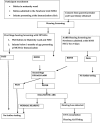Newborn and infant hearing screening for early detection of hearing loss in Nairobi, Kenya
- PMID: 38962342
- PMCID: PMC11217834
- DOI: 10.4314/ahs.v24i1.28
Newborn and infant hearing screening for early detection of hearing loss in Nairobi, Kenya
Abstract
Background: Early detection of hearing loss and subsequent intervention leads to better speech, language and educational outcomes giving way to improved social economic prospects in adult life. This can be achieved through establishing newborn and infant hearing screening programs.
Objective: To determine the prevalence of hearing loss in newborns and infants in Nairobi, Kenya.
Methods: A cross-sectional pilot study was conducted at the National hospital and at a sub county hospital immunization clinic. A total of 9,963 babies aged 0-3 years, were enrolled in the hearing screening program through convenient sampling over a period of nine months. A case history was administered followed by Distortion Product Oto-acoustic emissions (DPOAEs) and automated auditory brainstem response (AABR) hearing screening.
Results: The screening coverage rate was 98.6% (9963/10,104). The referral rate for the initial screen was 3.6% (356/ 9,963), the return rate for follow-up rescreening was 72% (258 babies out of 356) with a lost to follow-up rate of 28% (98/356). The referral rate of the second screen was 10% (26/258). All the 26 babies referred from the second screen returned for diagnostic hearing evaluation and were confirmed with hearing loss, yielding a prevalence of 3/1000.
Conclusions: Establishing universal newborn and infant hearing screening programs is essential for early detection and intervention for hearing loss. Data management and efficient follow-up systems are an integral part of achieving diagnostic confirmation of hearing loss and early intervention.
Keywords: Kenya; early detection; hearing loss; hearing screening; infant; newborn.
© 2024 Ndegwa S et al.
Conflict of interest statement
The authors have no conflicts of interest relevant to this article to disclose.
Figures
Similar articles
-
Hospital-based universal newborn hearing screening for early detection of permanent congenital hearing loss in Lagos, Nigeria.Int J Pediatr Otorhinolaryngol. 2008 Jul;72(7):991-1001. doi: 10.1016/j.ijporl.2008.03.004. Epub 2008 Apr 22. Int J Pediatr Otorhinolaryngol. 2008. PMID: 18433883
-
Early detection of neonatal hearing loss by otoacoustic emissions and auditory brainstem response over 10 years of experience.Int J Pediatr Otorhinolaryngol. 2019 Dec;127:109647. doi: 10.1016/j.ijporl.2019.109647. Epub 2019 Aug 21. Int J Pediatr Otorhinolaryngol. 2019. PMID: 31470205
-
Prevalence and referral rates in neonatal hearing screening program using two step hearing screening protocol in Chennai - A prospective study.Int J Pediatr Otorhinolaryngol. 2015 Oct;79(10):1745-7. doi: 10.1016/j.ijporl.2015.07.043. Epub 2015 Aug 8. Int J Pediatr Otorhinolaryngol. 2015. PMID: 26296879
-
Protocol and programme factors associated with referral and loss to follow-up from newborn hearing screening: a systematic review.BMC Pediatr. 2022 Aug 5;22(1):473. doi: 10.1186/s12887-022-03218-0. BMC Pediatr. 2022. PMID: 35932008 Free PMC article.
-
[The algorithm for clinical and audiological observation of children born preterm].Vestn Otorinolaringol. 2025;90(1):20-28. doi: 10.17116/otorino20259001120. Vestn Otorinolaringol. 2025. PMID: 40099331 Review. Russian.
Cited by
-
Postnatal cytomegalovirus infection and its effect on hearing and neurodevelopmental outcomes among infants aged 3-10 months: A cohort study in Eastern Uganda.PLoS One. 2025 Feb 6;20(2):e0318655. doi: 10.1371/journal.pone.0318655. eCollection 2025. PLoS One. 2025. PMID: 39913500 Free PMC article. Clinical Trial.
-
The Otoacoustic Emissions in the Universal Neonatal Hearing Screening: A Scoping Review Update on the African Data (2004 to 2024).Children (Basel). 2025 Jan 27;12(2):141. doi: 10.3390/children12020141. Children (Basel). 2025. PMID: 40003243 Free PMC article. Review.
References
-
- Yoshinaga-Itano C, Sedey AL, Coulteer DK, Mehl AL. Language of early and later identified children with hearing loss. Paediatrics. 1998;102:1161–1171. Doi: 10.1542/peds.102.5.1161. PMID: 9794949. - PubMed
-
- Watkin P, McCann D, Lawc, Mulee M Petrous, et al. Language ability in children with permanent childhood hearing impairment: The influence of early management and family participation. Paediatrics. 2007;120:E694–E701. Doi: 10.1542/peds.2006-2116. PMID: 17766510. - PubMed
MeSH terms
LinkOut - more resources
Full Text Sources
Medical


